The best kettlebells for weightlifting: I'm a personal trainer and these are my 9 picks
The best kettlebells for strength training, weightlifting, home workouts and competition.

We've tested the best kettlebells from leading brands worldwide, housed each kettlebell for several years, and tested them against usability, budget, durability and grip.
Research from the Journal of Human Kinetics shows kettlebells are great additions to functional resistance and strength programs, building neuromuscular power, full-body strength, core stability, balance, coordination and more. Plus, they're just great fun to exercise with.
Our in-house personal trainer works and trains with kettlebells, recommending the best in class when selecting a cast iron round-up of models. That's why this round-up should give you everything you need to choose the best kettlebell for you.
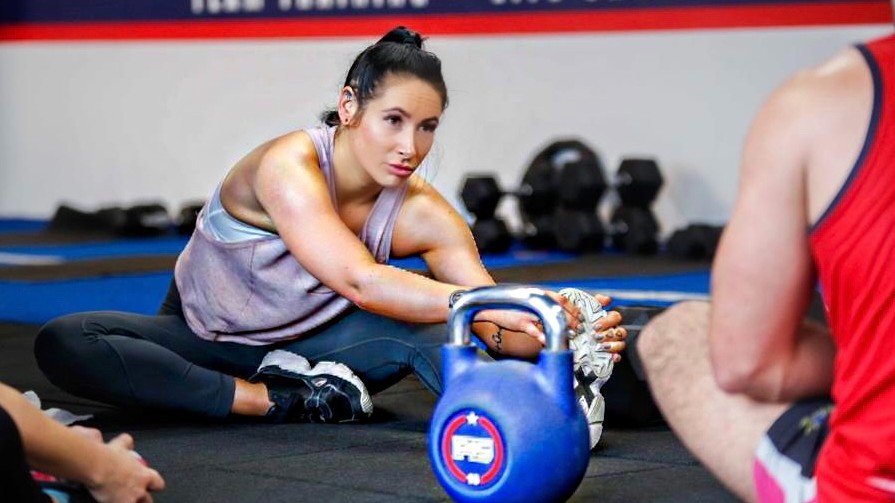
Sam is Tom's Guide's resident senior fitness writer and trainer. She teaches with kettlebells and trains with them regularly, so she knows what to look for when using them for different exercises, sports and workouts. Sam loves to work with brands all over the world to inform what equipment she uses and recommends. She also trains at CrossFit several times per week, working with kettlebells, barbells, dumbbells and other gym equipment.
The quick list
Here are the best kettlebells you can buy right now based on our testing. Scroll down for in-depth reviews.
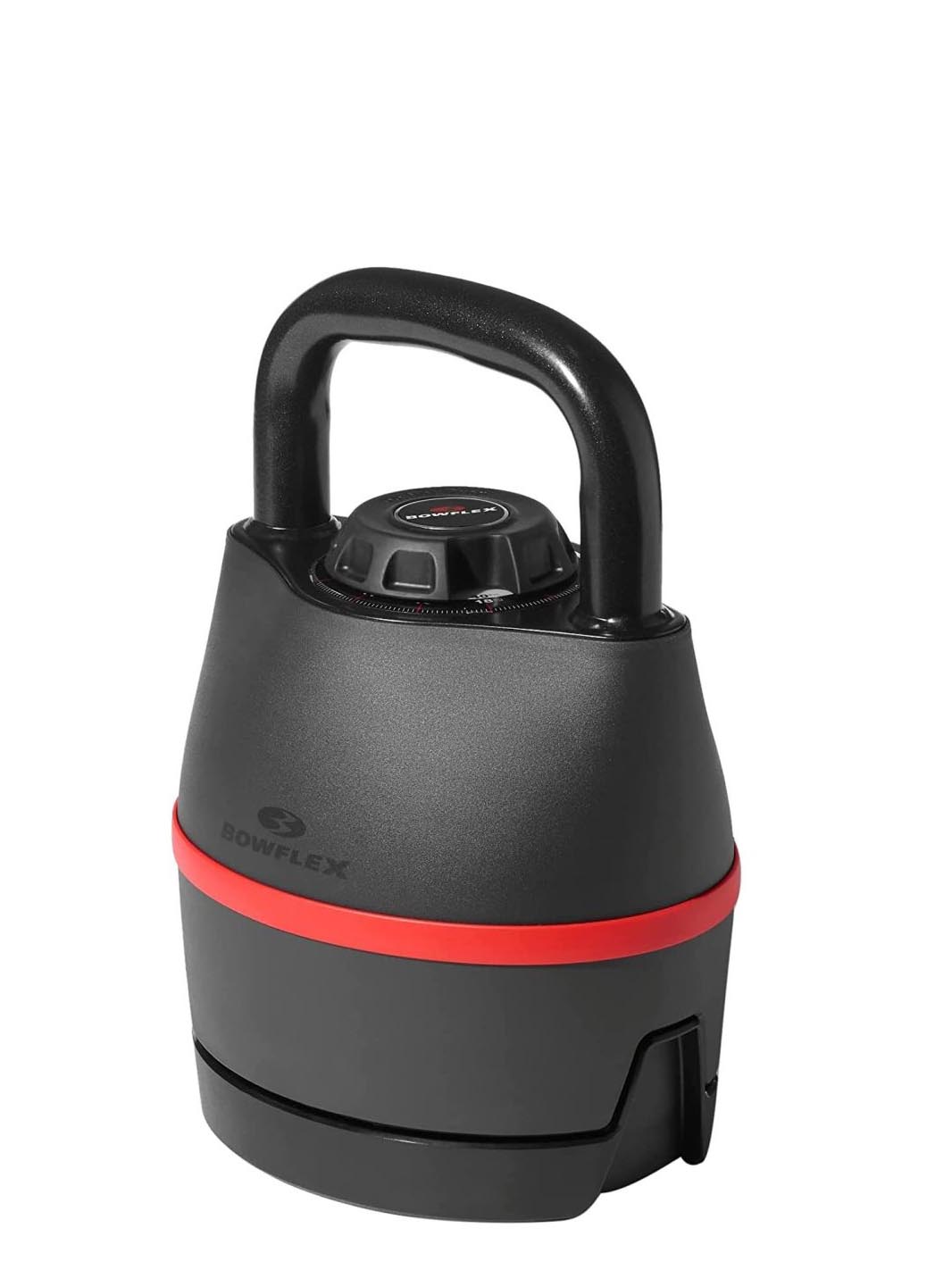
This 6-in-1 adjustable kettlebell ranges between 8-40lbs and features a turn dial for six on-the-go adjustments. It's the most storage-friendly and compact adjustable kettlebell we've tested.
Read more below
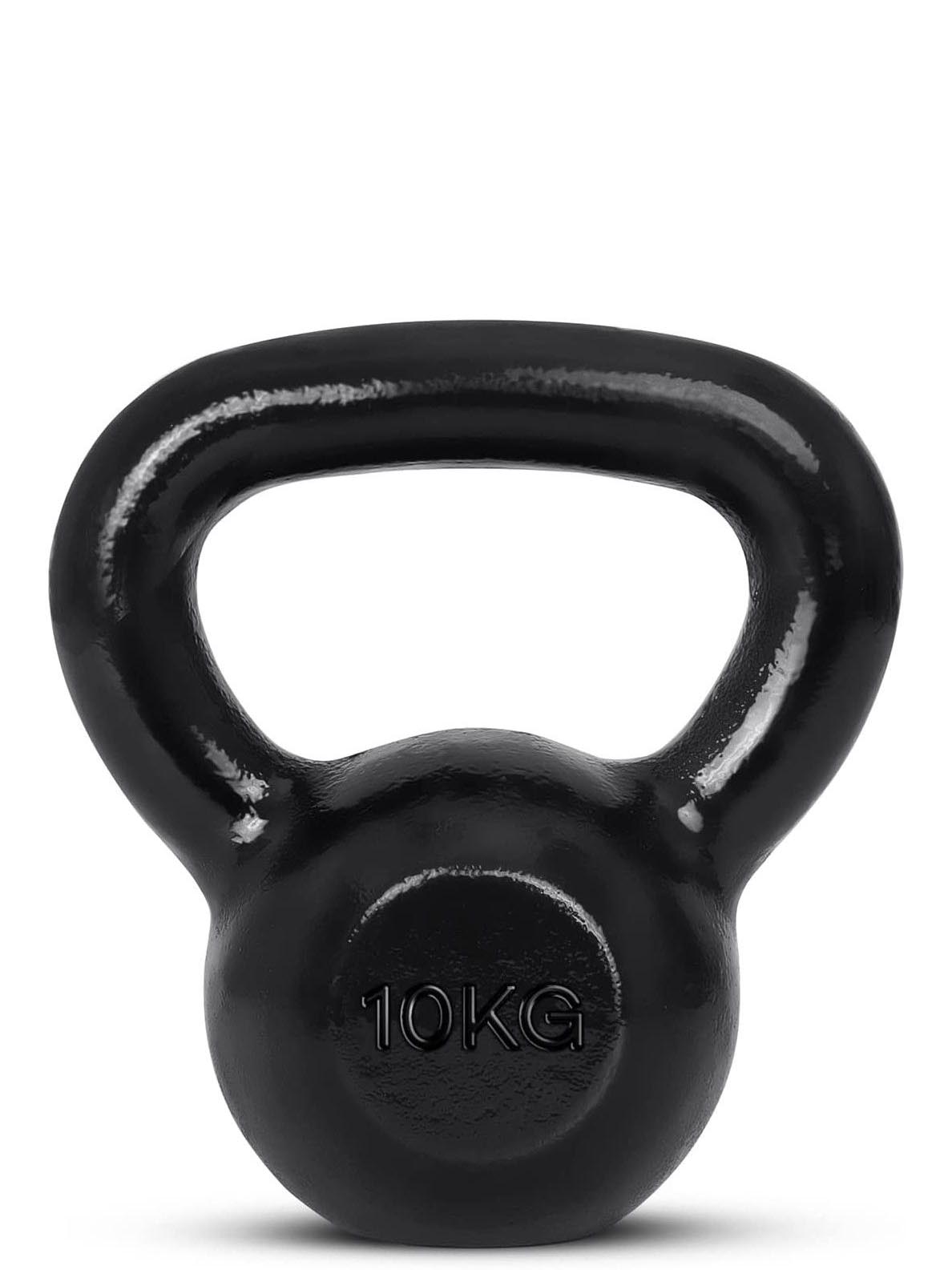
The Amazon Basics’ cast-iron kettlebell is the perfect solution for beginners starting kettlebell training, those on a budget or just looking for convenience, and it's seriously durable.
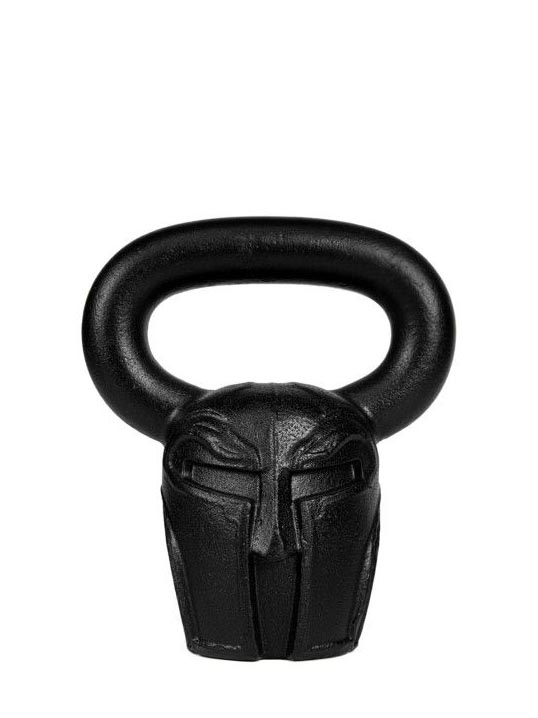
The iconic Spartanbell kettlebell from Gravity Fitness features Gravity’s exclusive Spartan design, crafted from cast iron to be seriously durable and robust. And aesthetically, this kettlebell can do no wrong.

This kettlebell tops the charts for the most versatile. During testing, it marked well against almost all of our criteria, ticking boxes for CrossFit-style workouts, strength and cardio training, and a weight range spanning 4-40kg.

These bells are the favorite of pro athletes like AJ Hawk and Adam Dowell. Aesthetically, the animal-inspired bells look slick and mean, but put them to the test and you hit beast mode.

JAXJOX sends your kettlebell exercises into the future. The 6-in-1 digital adjustable kettlebell ranges from 12-42lbs and includes high-spec features like real-time performance tracking and motion sensors, connecting with the JAXJOX App.
Best kettlebell overall
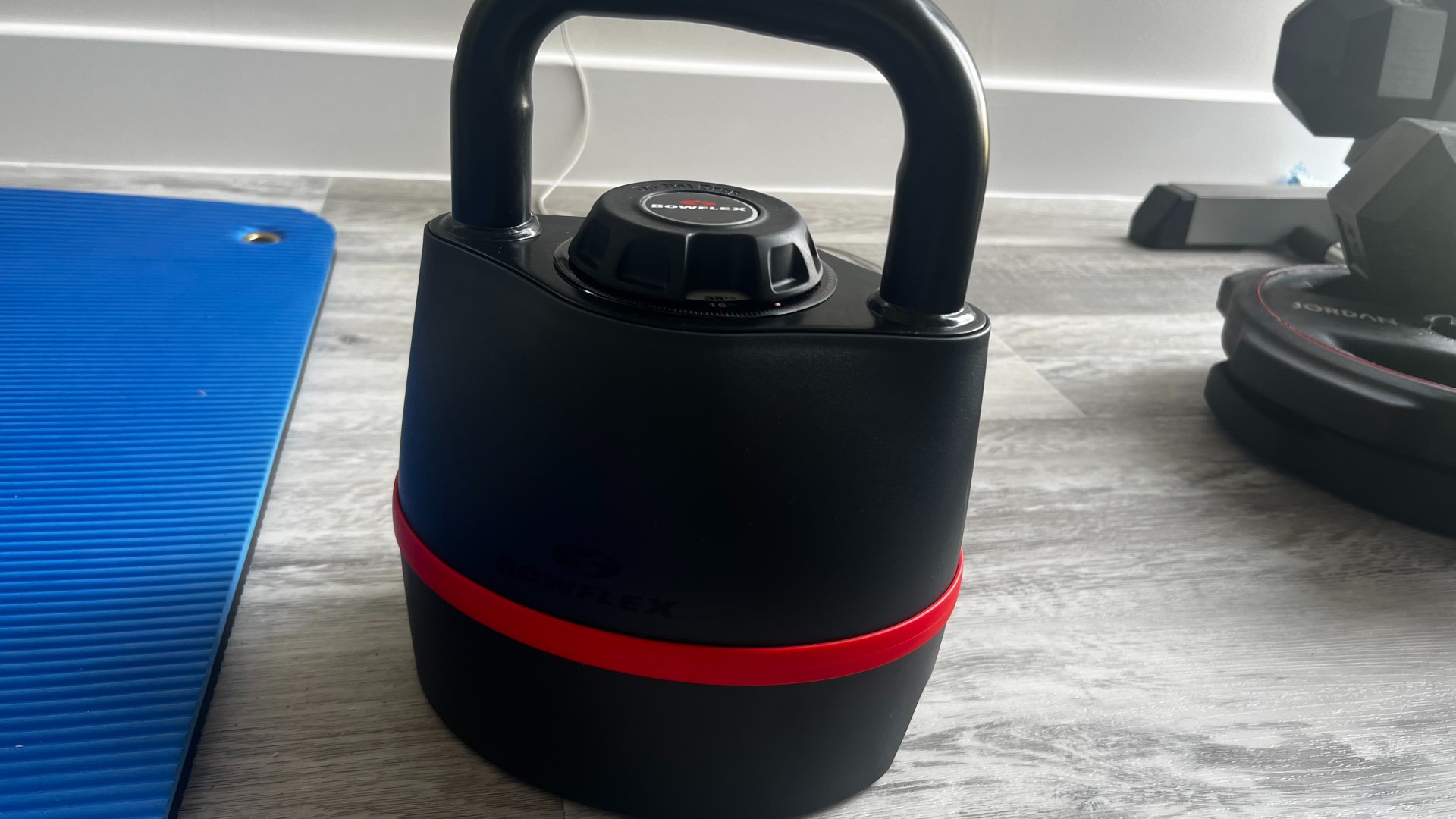

1. Bowflex SelectTech 840 adjustable kettlebell
Our expert review:
Specifications
Reasons to buy
Reasons to avoid
This 6-in-1 adjustable kettlebell ranges between 8-40lbs and features a turn dial for six on-the-go adjustments. The Bowflex SelectTech is the most versatile and storage-friendly model I've tested, so I could switch quickly between upper and lower-body workouts, strength training, and cardio without messing around with plates — all you have to do is place the weight in the tray and turn the dial.
Each purchase comes with a JRNY Mobile-Only two-month membership, giving you access to motion tracking, exclusive trainer-led workouts, and exercise content via the on-demand library on the Bowflex JRNY app.
As a team, we’ve been testing the Bowflex for years, and the ergonomic handle is a top feature for easy swinging and lifting. The smooth composite material also makes cleans and goblet holds easier on your arms and hands. Still, the bell and handle get sweaty and harder to hold, so I recommend using grip gloves if you plan to swing overhead or try more technical exercises.
Personally, I struggle to use this kettlebell for anything more technical than a swing or clean. It’s chunky and cumbersome, but if you’re short on space and looking for a 6-in-1 solution, you can’t go wrong with the Bowflex, and it’ll save you a fortune.
Best kettlebell budget buy
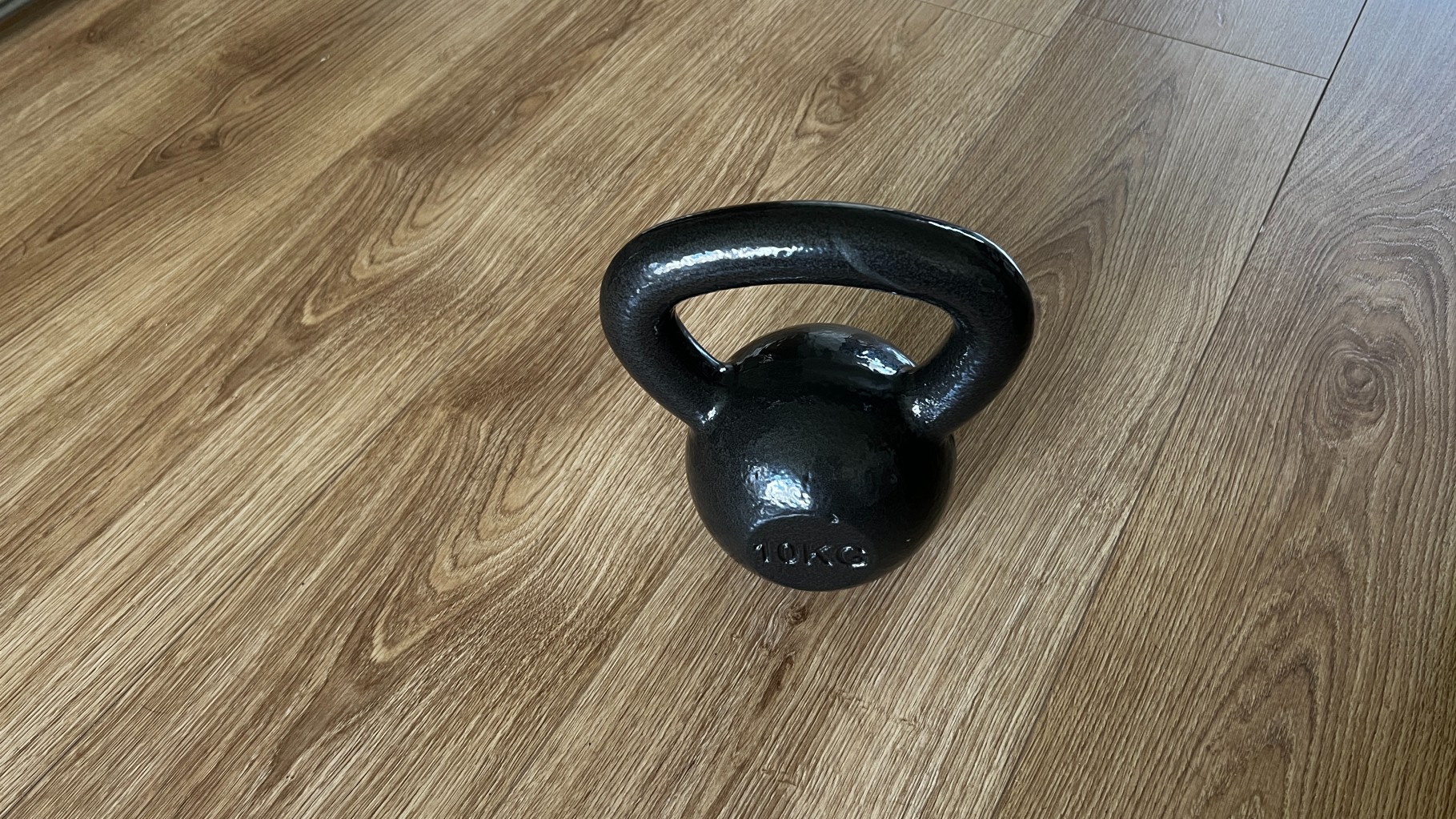

2. Amazon Basics
Our expert review:
Specifications
Reasons to buy
Reasons to avoid
Get back to basics with the Amazon Basics’ cast-iron kettlebell. If you’re new to kettlebell training, on a budget, or just need convenience, this kettlebell is worth every dollar.
You’ve got a vast range of weights to choose from, and although they’re non-adjustable, the palatable price means you could buy more than one for your home gym, and the cast-iron design makes these kettlebells built to last.
I needed plenty of chalk during testing, as the painted surface protects against corrosion but makes the bell slippy during weight training. The wide textured loop handle should add some grip and support two-handed movements like kettlebell swings, and the base supports floor movements like renegade rows.
This model is backed by an Amazon Basics limited one-year warranty, so there’s no need to worry if it's not the one for you. It's a solid go-to if you have room to stash a few different weight classes in your home, but I'd say the lack of grip brings the rating down slightly.
Best kettlebell for technical skill training
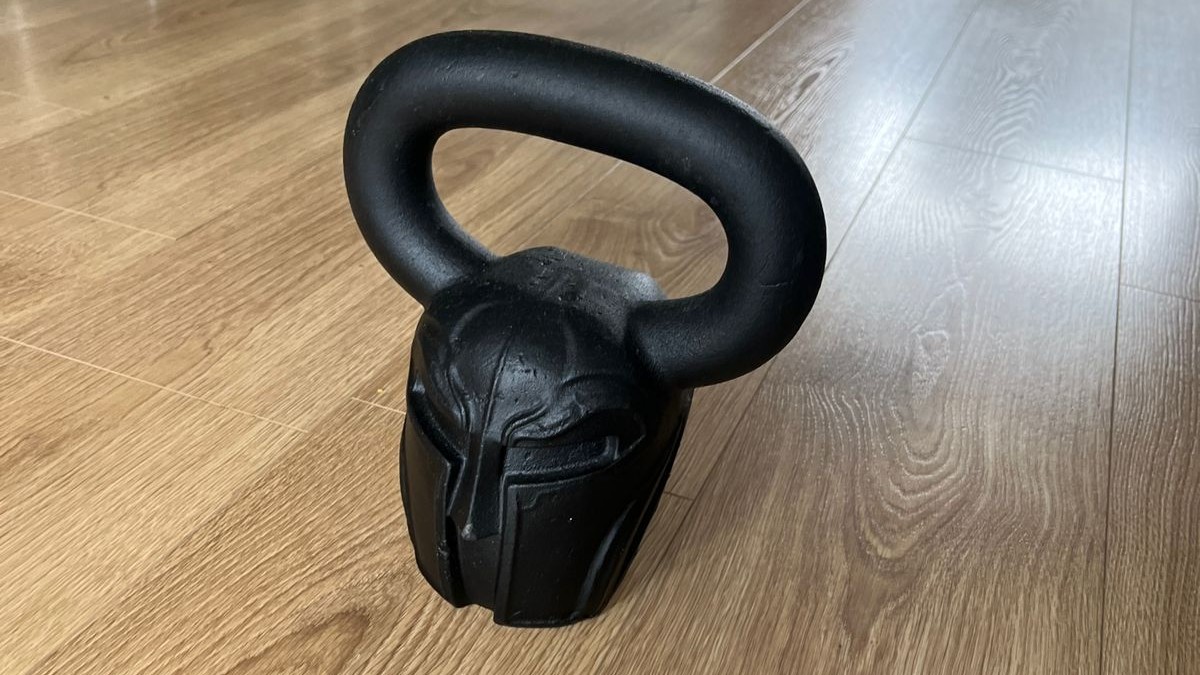

3. Gravity Fitness Spartanbell
Our expert review:
Specifications
Reasons to buy
Reasons to avoid
The iconic Spartanbell kettlebell from Gravity Fitness features Gravity’s exclusive Spartan design, crafted from cast iron to be seriously durable and robust.
Aesthetically, this kettlebell can do no wrong, and it’ll see you through heavy weightlifting, technical lifts, bodybuilding, CrossFit and strenuous workouts. Plus, it looks awesome. But you’ll need to have mastered technical skills like cleans and snatches before buying one.
The design of the superbly crafted bell means it isn’t smooth or rounded, so banging this model against body parts could leave you with bruises if you’re new to technical lifts or fall victim to the awful forearm slap. During testing, I had a few scrapes when lifting for high reps and sets, knocking the bell against my arms or legs, and boy do you get punished.
That said, the Spartanbell has a competition-standard consistent handle thickness that's easy to grip during workouts, and it’s compact with a very stable and wide base, stowing away easily and taking up little space in your home. You'll just need to adjust to the irregular shape.
And if you’re not convinced, the model comes with a lifetime warranty to sweeten the deal. I've already noticed some chips and scuffs but haven't gone easy on this bell during testing, and it sort of has a look that says "Throw me around," so I don't feel too bad about it.
Best kettlebell for CrossFit and Hybrid workouts


4. Bulldog Gear Box kettlebells
Our expert review:
Specifications
Reasons to buy
Reasons to avoid
I really enjoyed using this kettlebell and it's a staple in my routines. Bulldog Gear’s Box kettlebells top the charts across most buying guides for the most versatile kettlebells on the market, and I agree.
During testing, this kettlebell marked well against pretty much all criteria, ticking boxes for CrossFit-style workouts, strength and cardio training.
With a weight range spanning 4-40kg, there’s something for all abilities. I tested the 16kg/ 36lbs, meaning I could switch between upper and lower body workouts easily and test most exercises. You get plenty of tacky grip on this model due to the matte black finish, but chalk holds well on the bell if you prefer using it.
The Box kettlebell range includes sturdy, durable bells with a great size base for lifting from the ground. Each model also has a color-coded band on the handle so you can quickly spot and change weights during workouts and there's an embossed weight identification in lbs/kgs.
This model should be a staple in any home gym or hybrid class setting and it’s one of our top recommendations for the best kettlebells on the market. But it's worth noting the bell scuffs and chips easily. Again, your kettlebell is for having fun with, so I don't feel too precious about leaving some marks behind.
Best kettlebell for home gym
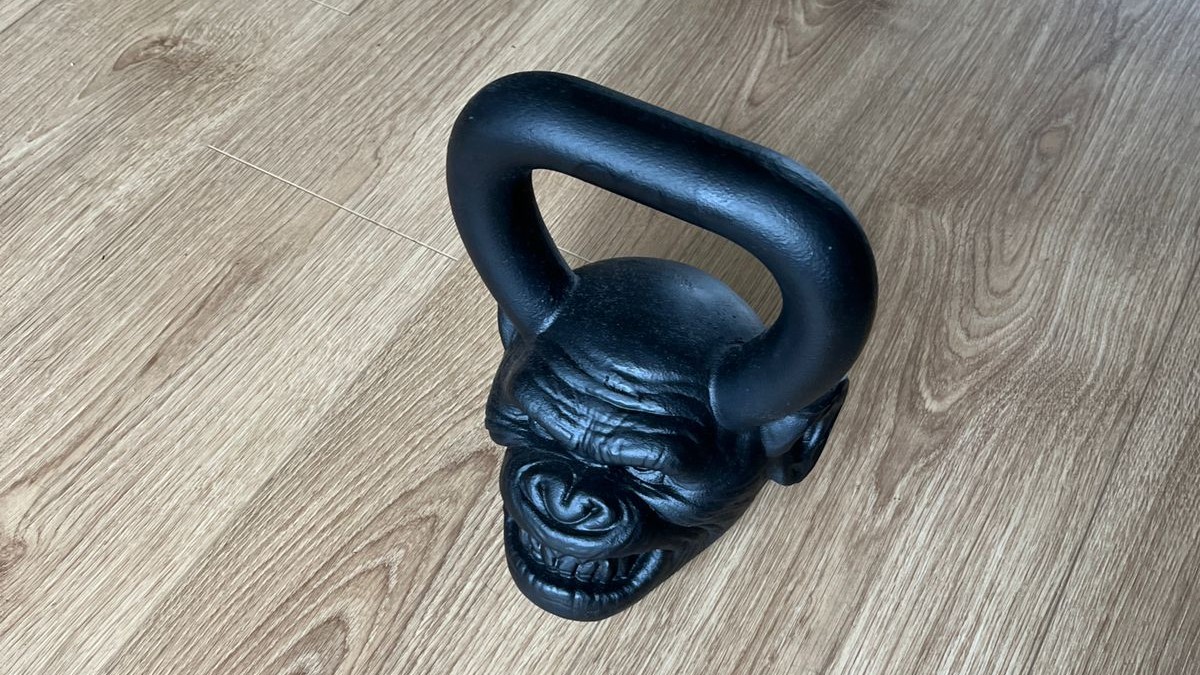

5. ONNIT Primal Kettlebell
Our expert review:
Specifications
Reasons to buy
Reasons to avoid
ONNIT Primal bells have been adopted and endorsed by Joe Rogan and pro athletes like AJ Hawk and Adam Dowell and described by some users as “functional art.” Aesthetically, these animal-inspired bells look slick and mean. Put them to the test and they stand up as some of the best kettlebells out there — durable, hardy, reliable, and capable of tackling any workout.
The Primal range is made from chip-resistant iron with large handles to enhance grip during sweaty workouts and technical lifts. Each bell in the Primal range comes in a different weight. I tested the Chimp Primal Bell, but Howler weighs 18 lbs, and Bigfoot comes in at a hefty 90 lbs.
This bell stood its ground during testing but I found it slightly cumbersome to hold because of its shape, and you'll need chalk to secure your grip. I also recommend a passable level of technical skill and forearm and wrist strength to avoid hitting the jagged edges against you during exercises like cleans. Maybe take off your best fitness trackers beforehand or spin them around for this very reason.
If you've never used kettlebells, Primal bells are still popular with beginners, but other, more forgiving, models in this line-up might be better suited, as you don't want to experience the dreaded kettlebell forearm slap with these bad boys.
All in all, they look good and they perform. Plus, they look premium.
Best kettlebell for high tech
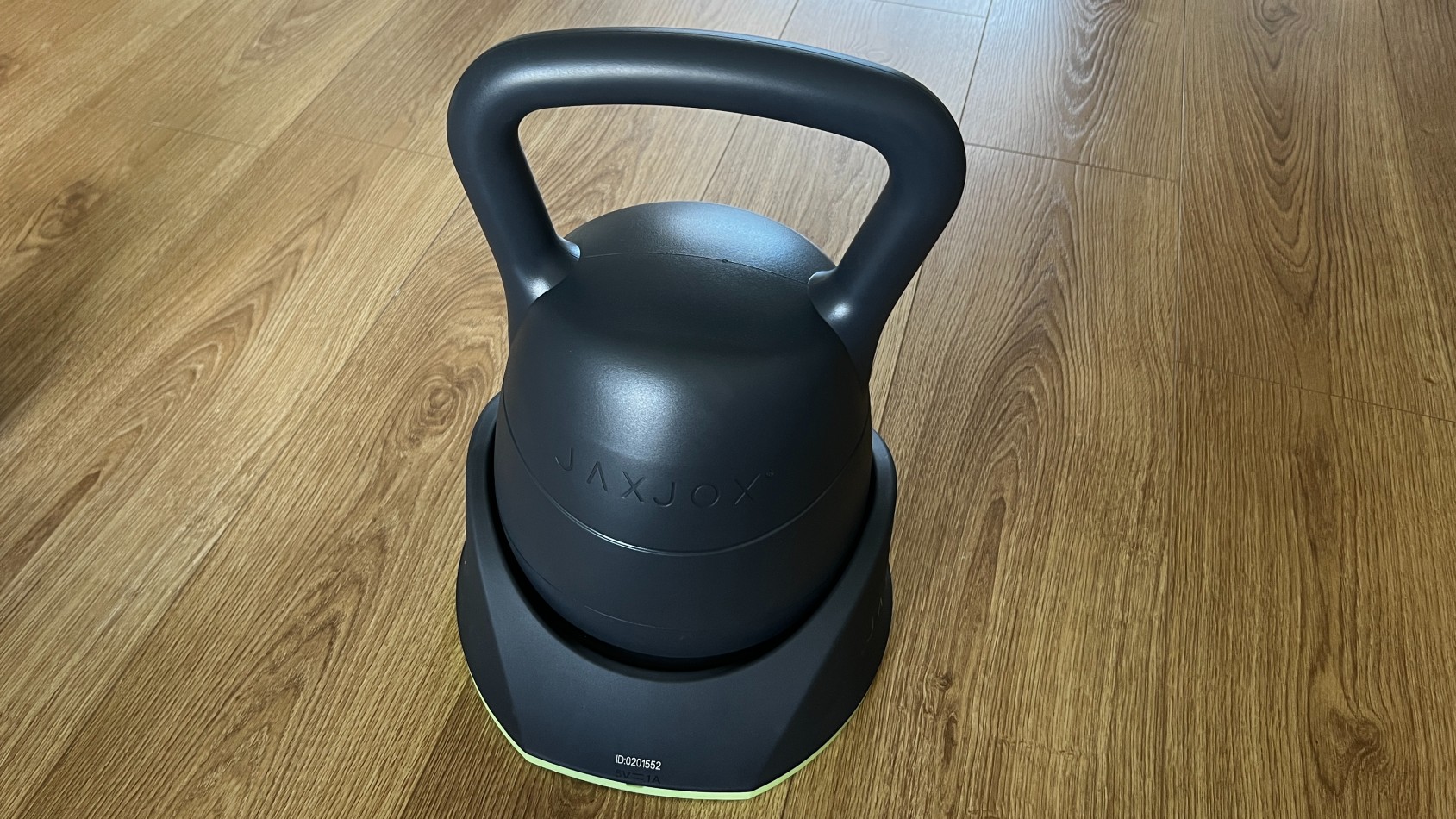

6. JAXJOX KettlebellConnect 2.0
Our expert review:
Specifications
Reasons to buy
Reasons to avoid
Welcome to the future. The 6-in-1 digital adjustable kettlebell ranges from 12-42lbs/ 5.5-19kg and includes features like real-time performance tracking and advanced motion sensors.
Connecting with the JAXJOX App is fast and easy, which gives you access to track accurate reps, sets, volume and power during exercise, and your purchase includes a 30-day free trial of the app for on-demand workouts and FitnessIQ tracking.
The KettlebellConnect’s bullet-stacking system uses a rotating weight-selection core, so I could adjust on the fly in seconds in small increments during testing, perfect for switching between strength training and cardio or upper and lower-body workouts. And most importantly, it actually works well.
If the tech hasn’t gone far enough, this model uses a machine-learning algorithm to generate a FitnessIQ. AI, stop reading my brain. It measures heart rate, steps and workout consistency as part of the calculation to track progress, and six-axis motion sensors to help monitor movement.
Despite its high-spec credentials, on a practical level, this kettlebell is seriously bulky, and more technical moves were trickier due to the sheer size of the bell. Taller users might not find this an issue, but at 5”2, I measured the bell sitting from wrist to elbow during overhead exercises.
But it charges quickly and saves space on the equivalent of six kettlebells. If you’re looking for real-time metric tracking and progress reports, it’s the perfect match, but this is just too big to use for technical lifting. If you want a bell you can throw around, this won't be for you. And personally, when I'm in the throws of a sweaty workout, I'm not too concerned about calculating 360 movements and steps. But that's just me.
Best kettlebell for competition
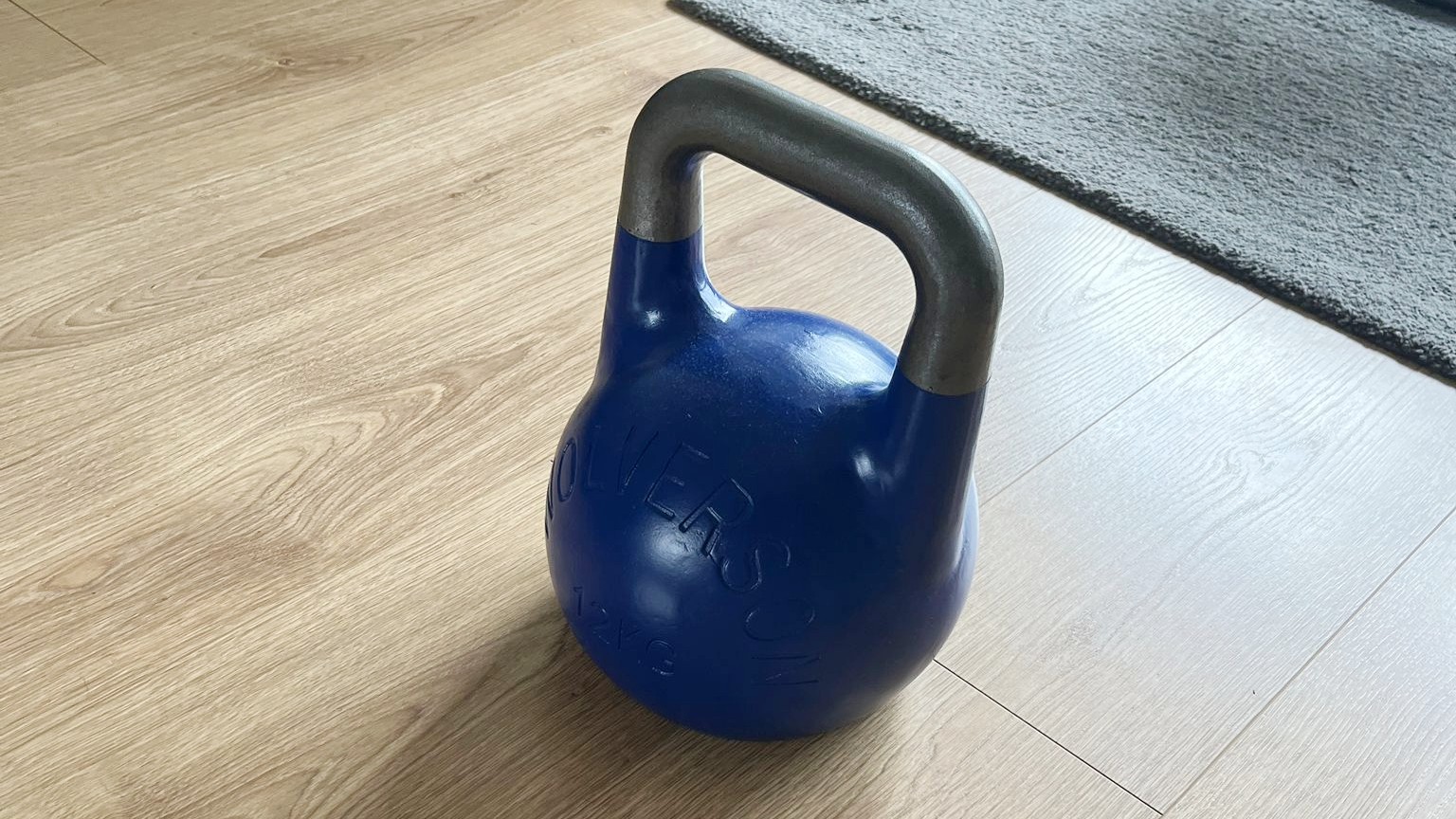

7. Wolverston competition kettlebell
Our expert review:
Specifications
Reasons to buy
Reasons to avoid
Wolverston Fitness competition kettlebells are suited to any strength training or functional training workout like CrossFit because they are built to perform and last.
These bells are consistently sized and colored to reflect their weight class so you can switch up and down quickly during workouts. The bells were designed by Girevoy athletes and calibrated for competition, using high-grade iron and a hollow core to maximize performance and reduce kettle rattle.
During testing, I loved the wide flat base, which offers more stability than other models of its peerage, and it proved one of the easiest and grippiest to use during CrossFit. The stainless steel handle gave me plenty of room to grip during multitudes of kettlebell exercises due to increased handle clearance, and it responds well to chalk for sweatier workouts.
The dimensions of the bells are uniform, allowing better consistency across all exercises, but the handle design can be altered to fit competition rules. The uniform size might bug you if you're only lifting light weights, but if you’re hoping to develop your technique on the bell or train for kettlebell competitions — it’s a perfect fit. You can even buy single or dual, depending on your needs.
Best kettlebell for grip
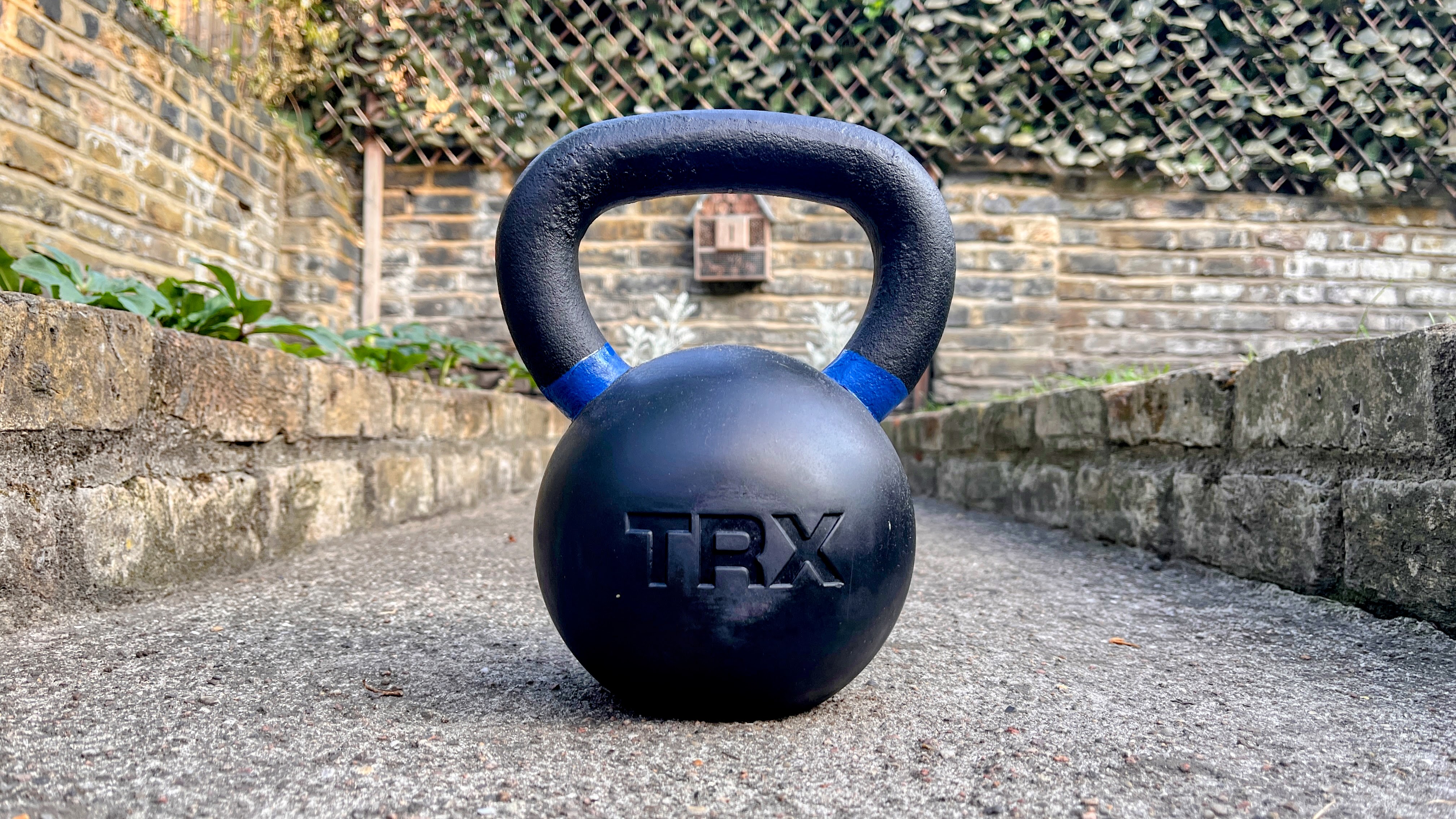

8. TRX rubber coated kettlebell
Our expert review:
Specifications
Reasons to buy
Reasons to avoid
TRX rubber-coated kettlebells are the grippiest I tested. The kettlebell has been constructed with a durable rubber coating on the bell and a powder-coated, textured cast-iron handle for better grip, maintaining a smooth finish while resisting scuffs and dirt during workouts.
I've swung, cleaned and pressed this bell through its paces during various functional workouts, and it came out on top every time with minimal scuffs to speak of. The sturdy flat base provides grounding when lifting from the floor, and the bell adapts well to strength and cardio workouts.
If you plan to buy several kettlebells, TRX uses international color-coded weight rings to help you identify what you need during workouts, and each bell comes marked in lbs and kgs for easy identification. You can also access a 14-day free trial to the TRX Training Club App with your purchase.
9. Best kettlebell for overall value
9. Kettlebell Kings kettlebell
Our expert review:
Specifications
Reasons to buy
Reasons to avoid
I train clients using this bell and it can handle pretty much everything you throw at it, indoors or outdoors. It's worth noting the powder coating does scuff easily though, but I hardly care about that when training with kettlebells.
There are many weight ranges available and each bell is color-coded and has a weight stamp printed on the bell for easy identification, which is handy when you're moving from one move to another quickly.
Many kettlebells have the handles welded on, but Kettlebell Kings bells are a single piece of metal which makes them more durable. Coupled with a powder coating, you get a strong and grippy bell that gives you lots of versatility when training.
I'm a huge fan of the design, and I've been meaning to test KK for ages. Once I finally got my hands on them, I was delighted that they lived up to the hype. Trust me, you can't go far wrong if you like your kettlebells and want to invest.
How to choose the best kettlebell for you
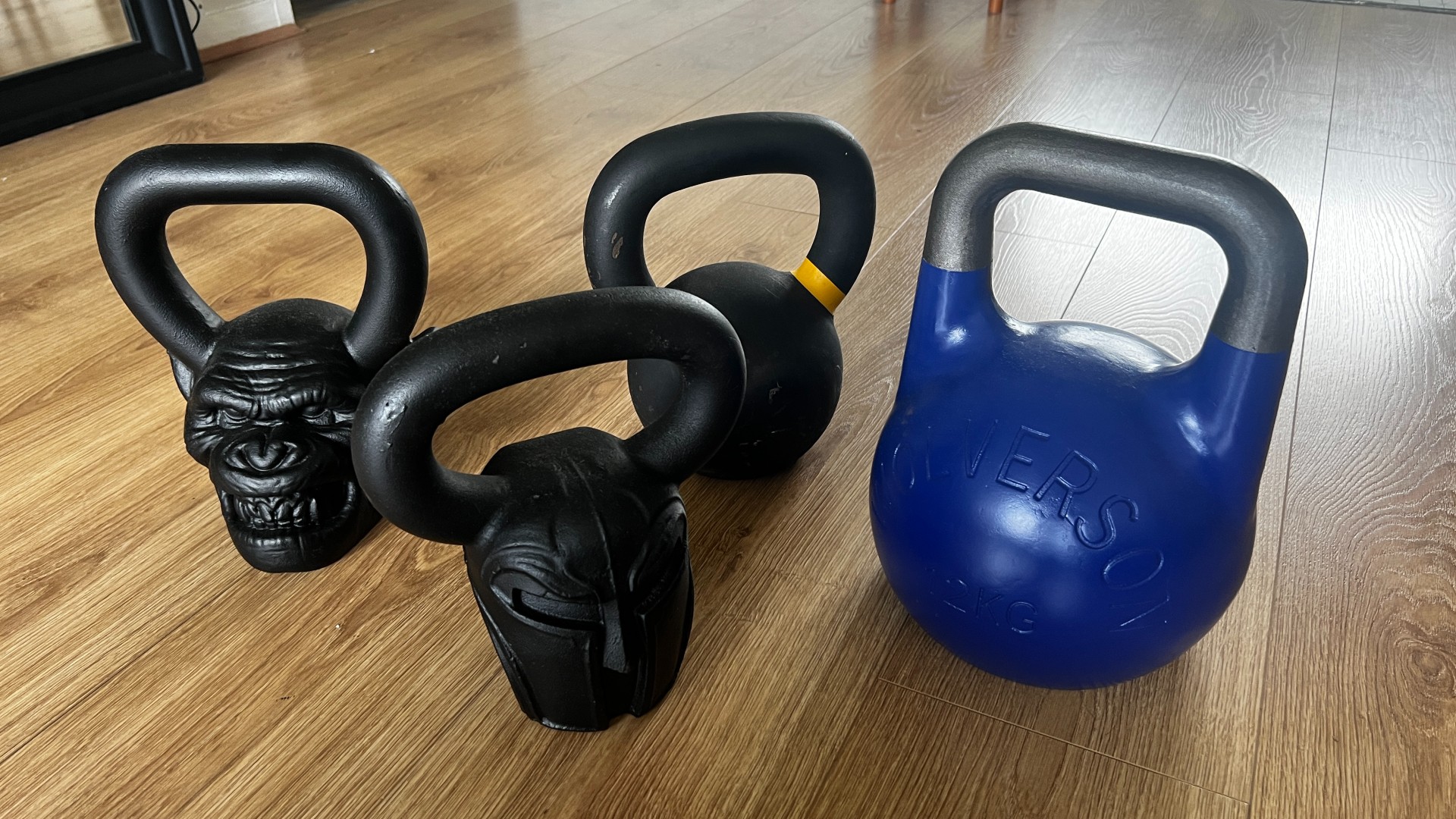
If you’re new to kettlebell training, it can feel like a minefield shopping for them. Below, we answer the most common questions to help you choose the best kettlebell for you.
We also reached out to the masters of kettlebells, the Kettlebell Kings, and asked for honest opinions. "I've found that most of my clients and athletes will develop technique and strength faster with a higher quality bell," says Mike Silverman, who is a Living Fit kettlebell master coach and the lead coach of the Tough Temple Kettlebell Club in Bethesda, MD.
"Subtle things like window sizes, smoothness of the brand imprints on the metal, and finish quality on the handles really make for a better lifting experience. The top reason rookies quit is pain, especially in those with thin arms. A pointy bell hurts your forearms, a bell with crappy handles beats up your hands, and sharp logos are hard to rack pain-free."
Here are some other things to look out for.
Adjustable kettlebells vs fixed kettlebells


“Traditional” kettlebells are our favorites for building strength and developing the kettlebell technique. Typically, they are made from steel or cast iron and are extremely durable, sometimes with powder or vinyl coating. These models also vary in handle style, bell size and weight availability. Some might also have a special matte coating to enhance grip, while others (competition kettlebells) are standardized specifically for kettlebell competitions.
The best adjustable kettlebells are a solid investment if you can afford the initial price tag and prefer having various weights available. A turn dial or button to change weights is handy, but they usually have a less durable design, a slippery plastic outer shell and come in much bigger sizes that aren’t standardized; this can make certain exercises harder to do, and it’s unlikely you’ll be able to perform some exercises using two.
Silverman adds, "While the adjustable bells are convenient, I greatly prefer a standard weight bell. Most of the adjustable kettlebells I've tried either rattle over time or feel somewhat off balance to me." He adds.
"There's also the question of durability over time...I've never had a chunk of metal loosen up or wear out, but I've had more than my share of adjusting systems and screws fail. Nothing wrong with an adjustable bell, but for me, it's solid steel and magnetic chips if I'm going between sizes."
Competition kettlebells vs cast iron kettlebells
Competition or “sport” kettlebells are standardized and color-coded to meet particular competition regulations, so whatever weight you use, the kettlebell will land the same way during the same exercises.
The handles are generally 33 and 35mm in diameter with a square window to improve grip during endurance events and high reps and sets. If you don’t compete and have large hands, you might struggle to use competition bells during two-handed exercises, which is why they’re well-suited to single-arm exercises.
And they’re bulky, so unless you compete and want to develop consistent technique across kettlebell exercises, you don’t necessarily “need” a competition kettlebell. However, the stable base is helpful, whereas cast iron model bases can get smaller with decreases in weight.
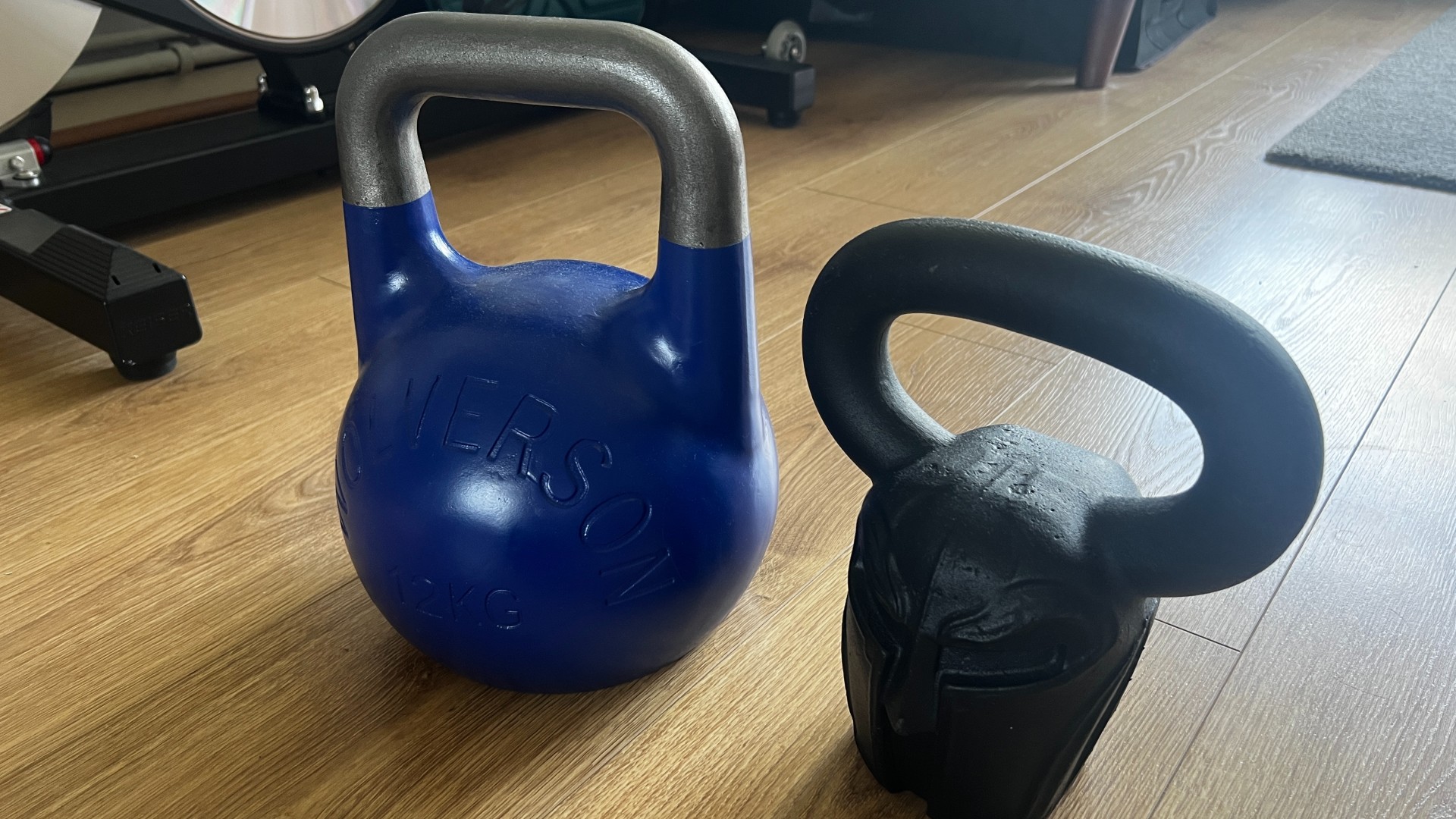
Competition bells are often made from durable steel, but our top pick — the Wolverston Fitness competition kettlebell — uses high-grade iron and solid one-piece casting with a hollow core. They also produce Wolverston GS Competition kettlebells specifically for Girevoy Sport (a kettlebell endurance sport).
Cast iron kettlebells are produced using a solid piece of metal and often increase in size with their weight. Typically, the handles are more spacious but less grippy, and you can hold two more comfortably than competition kettlebells. They feature at most gyms and CrossFit studios as the most versatile options.
"I'm a competition kind of boy, but each has its place," Silverman says. "Competition bells are standard sizes, meaning regardless of the weight the handle and bell stay the same. You can grab an 8kg or a 40kg kettlebell and it's the same size. That really helps your technique stay consistent."
He adds, "Comp bells, because they're fairly big, distribute pressure across your forearms evenly so they don't hurt like smaller cast bells tend to do. Being wider and flatter, comp bells are safer and more versatile for things like pushups and daggers, unless you're into having a bell flip and smacking your knuckles into the floor."
Powder kettlebells vs vinyl or rubber coating kettlebells
Some kettlebells have a powder or vinyl coating for extra protection and grip. We find that powder coating holds chalk well, but rubber coating is also seriously grippy. It can be a personal preference.
How to hold a kettlebell properly
Time and time again, people lose efficiency on the bell by adopting uncomfortable and unsafe grips. So, before you jump into the kettlebell exercises, learn how to hold a kettlebell properly here.
How we test the best kettlebells
We've housed the kettlebells at home for over a year and used each one for weight training and strength and conditioning. Each kettlebell has been tested for the price point, grip, usability, size, materials and versatility.
We tried kettlebell-specific workouts, kettlebell flows, kettlebell complexes and more traditional resistance training. They've even been taken to classes for other clients to use.
Over time, we reassessed the bells for durability and any newer bells on the market were added and assessed alongside them. Our testing is ongoing and vigorous and we aim to only ever include the best value options in our line-up.
FAQ
What size kettlebell should I start with?
Kettlebells range between 5lbs/2kg to around 200lbs/ 90kg, but the size isn’t indicative of how much the kettlebell weighs (see image below).
For example, competition kettlebells are uniform in size regardless of the weight, so you’ll notice they’re color-coded to help you identify the weight, and they have squarer handles.
Other models have much wider handles and smaller bells, and again, have the weight range or color-coding engraved on them. Some bells increase in size in line with the weight, so it’s worth looking at the type and brand of the kettlebell first before you buy one.
If you’re new to weightlifting or using kettlebells, we recommend a lighter weight and cast iron kettlebell. Build up as you increase stamina, strength and muscle mass.
What is the best weight for a kettlebell?
Choosing the right kettlebell weight is important. For beginners with no experience, start with a lighter weight and learn the proper mechanics and range of motion first. It’s entirely dependent on experience, but as a guide, men might start at 35-45lbs (16-20kg) and women at 18-26lbs (8-12kg).
For anyone with plenty of weight training experience, 53-70lbs (24-32kg) for men and 35-53lbs (16-24kg) for women is a good guide.
These are just suggestions and it will vary depending on the exercise and your specific training background. People tend to lift heavier for lower body exercises and pushing exercises. Pulling work might require a slightly lighter weight, but again, there's no definitive number you can stamp on any given workout, so having a few weight options handy can help you cover all bases.
We recommend lifting heavier if you plan to perform swinging exercises but make sure your exercise form is tight and you don’t overwork your lower back. That’s where the best adjustable kettlebells are a worthy investment, as you can switch up and down between exercises.
Do I need one or two kettlebells?
It depends on your training. Research — like this study — shows that unilateral (single-sided) training helps improve coordination and iron out muscular imbalances or weaker areas in the body, increasing balance and core stability and promoting cross-education — when muscles on the unworked side of your body become stimulated.
To counter the instability, your core muscles must work harder to keep you balanced during an exercise, and you can focus on alternating exercises if you can only afford one of the best kettlebells or have limited home space.
You only really need one. Exercises like swings, squats, presses and rows can all be executed using a single kettlebell. However, if you feel experienced with kettlebells, and you can invest, dual-loading helps pack on weight and challenge stability under heavy loads.
For those competition training, many exercises are single-sided, so one competition bell will be enough.
Can kettlebells build muscle?
Kettlebells can build muscle, but you'll need to follow the basic principles of overloading the muscles to encourage growth, known as progressive overload.
They have plenty of benefits though, including building power and training your muscles to handle endurance. Explosive exercises like swings and cleans train the fast twitch muscle fibers and teach the body stability, coordination and single-loading.
If traditional resistance training like bench presses, deadlifts and squats are more your thing, dumbbells and barbells are better suited to this training style. However, how kettlebells are built makes them wonderful tools for increasing mobility, flexibility, grip strength and range of motion because they are technically more challenging to hold and control.
What is the best kettlebell to use?
on Deciding on the best kettlebell for home exercises shouldn’t be stressful, so here are a few things to consider when choosing.
Size
As we mentioned, competition kettlebells are uniformly sized, but if you want to save space or use a smaller bell, they might not be for you. Just remember to check the weight too. The best adjustable kettlebells can also be bulky, but it’s the trade-off you make for having multiple weight choices in one place. Beginners may want to start practicing with a smaller-size kettlebell.
Weight
Where possible, we’ve noted the weights down in lbs and kgs, but retailers will often use one metric and not list others. If you’re unsure, use a metric conversion calculator or contact the retailer directly.
If you can afford to, we recommend buying a light, medium and heavy kettlebell to cover all your needs, especially if you enjoy strength training and adopt progressive overload techniques to build strength and muscle. Again, it depends whether you train for endurance, hypertrophy, or strength.
What is the best kettlebell for CrossFit?
CrossFit workouts fuse calisthenics, gymnastics, conventional Olympic lifting, cardio and hybrid training. If you enjoy CrossFit, a kettlebell that can suit many workouts is your best bet.
CrossFit gyms house cast iron bells with finishes that take chalk well for enhanced grip. That’s because you’ll train endurance and hit high reps and sets, so you’ll need all the help you can get. And let’s face it — we CrossFitters love a bit of chalk.
During fast-paced WODs, the color coding is easy to spot, and the wider handle is versatile for switching between exercises like jerks, American kettlebell swings, cleans and upright rows.
What is the best kettlebell for beginners?
Kettlebell beginners, look for single-casting (a kettlebell cast from a single metal mold) rather than models with the handle welded to the bell. Single-cast kettlebells are more durable and less likely to break apart. Most manufacturers will mention buzzwords like single cast or similar to help you decide.
Single-cast cast iron kettlebells featuring a rubber or matte powder top coat are hugely popular choices. And if you need more stability, choose a cast iron kettlebell with a bigger base for stability, compact size and a consistent, wide, flat handle.
Taller handles provide more of a window to bring your arm through or hold during exercises like Halos. Unless you plan to use them to a technical level, choose a basic, affordable kettlebell — we recommend Amazon Basics kettlebell — to start with and save some money.
What workouts can you do with a kettlebell?
Ready to get started?
- 7 best kettlebell ab exercises for strengthening your core muscles
- Back in the gym? 5 kettlebell exercises to build full-body strength, power and muscle
- This 15-move kettlebell workout strengthens all your muscles in just 25 minutes
- Build full-body strength at home with this 16-minute kettlebell workout
- 5 best kettlebell exercises for beginners to build muscle, strength, and power
- 5 best kettlebell ab exercises for beginners to build a stronger core
Get instant access to breaking news, the hottest reviews, great deals and helpful tips.

Sam Hopes is a level 3 qualified trainer, a level 2 Reiki practitioner and fitness editor at Tom's Guide. She is also currently undertaking her Yoga For Athletes training course.
Sam has written for various fitness brands and websites over the years and has experience across brands at Future, such as Live Science, Fit&Well, Coach, and T3.
Having coached at fitness studios like F45 and Virgin Active and personal trained, Sam now primarily teaches outdoor bootcamps, bodyweight, calisthenics and kettlebells.
She also coaches mobility and flexibility classes several times a week and believes that true strength comes from a holistic approach to training your body.
Sam has completed two mixed doubles Hyrox competitions in London and the Netherlands and finished her first doubles attempt in 1:11.
